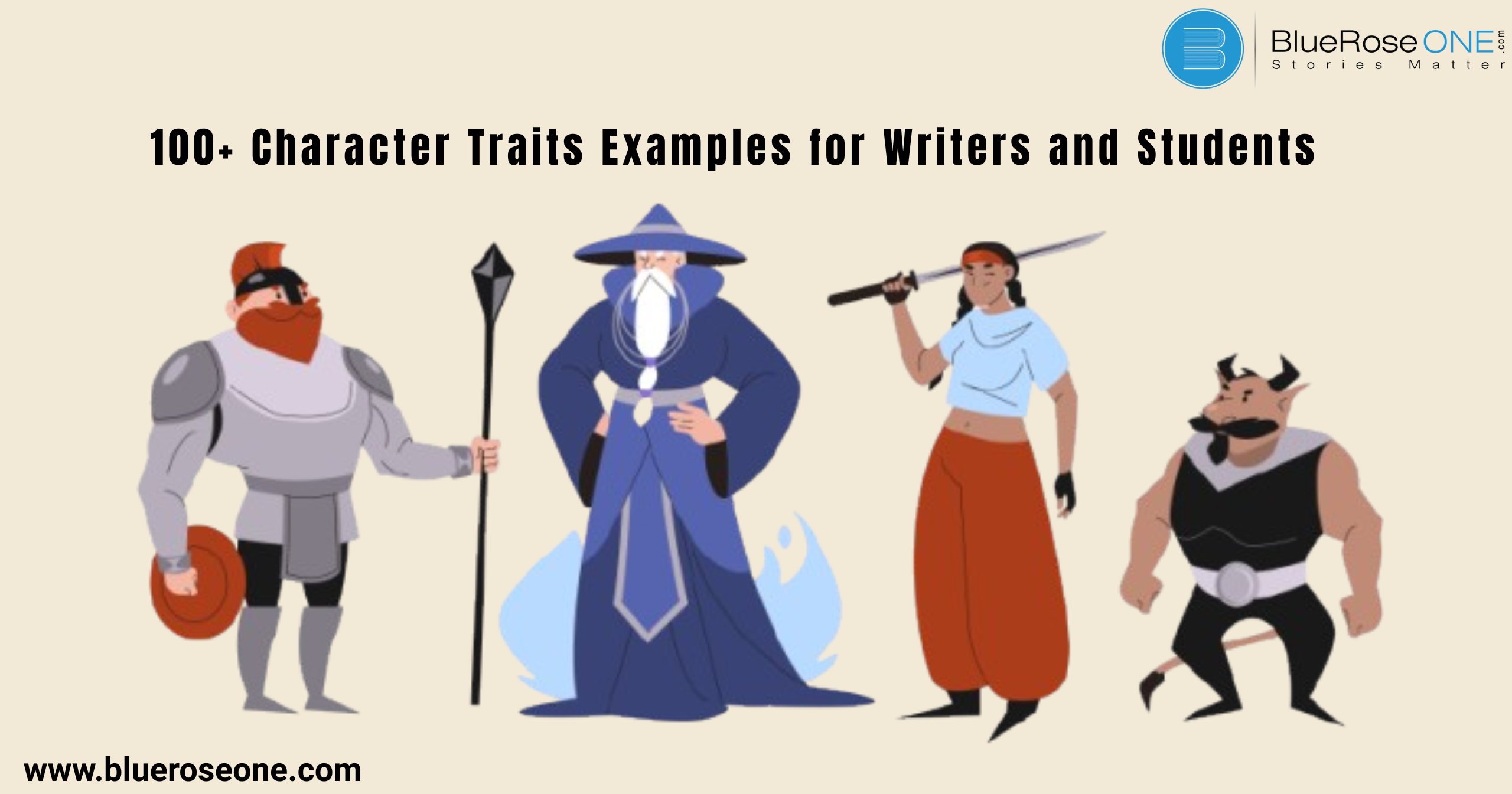Ever stared at a blank page trying to figure out who your character really is? Or maybe you’re a student breaking down a character in a novel for your essay. Either way, character traits are the building blocks of compelling personalities.
Understanding character traits can help bring your stories to life or help you ace your literature assignments. This article gives you a massive list of 100+ examples plus tips on how to use them like a pro.
What Are Character Traits?
Character Traits vs. Emotions
Traits are consistent qualities that define how a person behaves over time. Think of emotions as fleeting; someone might feel angry today, but if they’re often angry, that’s a trait: short-tempered.
Internal vs. External Traits
- Internal traits involve thoughts, values, and beliefs (e.g., loyal, compassionate).
- External traits are often visible in behavior (e.g., loud, clumsy).
How Traits Shape Behavior
Character traits significantly influence how individuals perceive situations and respond to challenges. For example, a courageous person may take risks others avoid, while a patient person might remain calm under stress. These internal qualities guide decisions, shape moral judgments, and drive consistent behavior, helping define a character’s identity and actions.
You may also like: Top 10 Must-Read Aadvika Pommu Novels (ஆத்விகா பொம்மு)
You may also: Read: Realistic Fiction: Definition, Key Elements and Examples
How to Use Character Traits in Writing
Developing a Believable Character
Developing a believable character means giving them consistent traits, motivations, and flaws that mirror real human behavior. Start by choosing a few core traits like optimism or jealousy and show them through actions, dialogue, and reactions.
Characters feel authentic when their traits influence their decisions and grow over time. Adding contradictions or internal conflict like a brave person afraid of failure adds depth and relatability, making readers more emotionally invested in their journey.
Character Arcs and Growth
Character arcs and growth refer to a character’s emotional or psychological transformation during a novel. Character qualities are used by writers to chronicle this change, such as fear to courage and selfishness to empathy.
A well-developed arc helps characters feel real and approachable, reflecting their motives and experiences. By deliberately modifying qualities, authors can create interesting storylines in which readers see internal struggles, successes, and significant development throughout time.
Using Traits to Create Conflict
Using character traits to create conflict adds depth and tension to your story. Opposing traits like stubbornness versus flexibility or honesty versus deceit naturally lead to clashes between characters.
Even internal conflicts arise when a single character’s traits contradict their goals (e.g., a brave but impulsive hero). These tensions drive the plot forward and make characters more believable, compelling readers to stay invested in the outcome.
You may also like: Diva Secret Cellular Nutrition Therapy by Dr. Wandoh Timothee Djimet: Book Summary
You may also like: Top 10 Arundhati Roy Books You Must Read in 2025
How Students Can Use Character Traits
Reading Comprehension
Understanding character traits can greatly improve reading comprehension by helping students analyze and connect with literary texts on a deeper level.
When students identify traits like bravery, jealousy, or kindness in characters, they begin to predict actions, recognize motivations, and interpret conflicts more accurately.
This insight supports better inference-making and textual analysis. By mapping traits to plot development, students also enhance their critical thinking, which is a key skill for academic success across subjects.
Essay Writing and Literary Analysis
In essay writing and literary analysis, understanding character traits helps students form deeper insights into a story’s themes and conflicts. Students can use a character’s qualities, like bravery, jealousy, or humility, to explain relationships, motivations, and pivotal moments when analyzing literature.
This enhances critical thinking and supports stronger thesis statements. For example, analyzing Lady Macbeth’s ambition helps explain the tragic downfall in Macbeth. Including character traits in essays also enriches textual evidence and argument clarity.
Personal Development and Self-Awareness
Understanding character traits enhances students’ personal development by promoting self-awareness and emotional intelligence. By identifying qualities like perseverance, empathy, or impulsiveness in themselves, students can reflect on their strengths and areas for growth.
This self-knowledge helps them set personal goals, build healthier relationships, and make thoughtful decisions. Recognizing and nurturing positive traits fosters confidence and resilience key factors for academic success and lifelong emotional well-being.
You may also like: What is a Title Page? Definition, Purpose and Examples
Intellectual Traits
- Curious
- Wise
- Insightful
- Logical
- Creative
Social Traits
- Friendly
- Charismatic
- Loyal
- Humble
- Supportive
Emotional Traits
- Empathetic
- Optimistic
- Calm
- Patient
- Kind
Moral Traits
- Honest
- Fair
- Brave
- Responsible
- Forgiving
You may also like: Pacing Definition in Literature: Guide for Writers and Authors
Negative Character Traits
Manipulative Traits
- Deceitful
- Cunning
- Controlling
- Scheming
- Dishonest
Self-Destructive Traits
- Addictive
- Impulsive
- Insecure
- Jealous
- Arrogant
Socially Toxic Traits
- Rude
- Selfish
- Racist
- Intolerant
- Aggressive
You may also read: 10 Best Books on Writing Every Aspiring Author Should Read
You may also like: 100 Adjectives Start with Z (With Meanings & Examples)
Neutral or Ambiguous Traits
Traits That Depend on Context
- Stubborn (can be seen as determined)
- Shy (can also be thoughtful)
- Bold (or maybe reckless)
- Independent (or aloof)
- Skeptical (or insightful)
Anti-Hero Qualities
Characters like Walter White or Katniss Everdeen have traits that toe the line:
- Ruthless
- Sarcastic
- Cold
- Strategic
- Disillusioned
100+ Character Traits List (A to Z)
A-E
- Adventurous
- Affectionate
- Ambitious
- Anxious
- Brave
- Bossy
- Careful
- Clever
- Curious
- Diligent
- Dramatic
- Energetic
- Empathetic
F-J
- Fearless
- Flexible
- Friendly
- Funny
- Generous
- Grumpy
- Honest
- Humble
- Imaginative
- Impatient
- Jealous
- Joyful
You may also like: What is the Ruler Archetype? Definition with Powerful Examples
K-O
- Kind
- Lazy
- Loyal
- Mischievous
- Moody
- Naive
- Noble
- Observant
- Obnoxious
- Optimistic
P-T
- Passionate
- Polite
- Proud
- Quick-tempered
- Rational
- Reliable
- Resourceful
- Sarcastic
- Shy
- Strong-willed
- Talkative
- Tense
- Thoughtful
U-Z
- Unpredictable
- Vain
- Versatile
- Warm-hearted
- Witty
- Wise
- Withdrawn
- Zealous
You may also read: What is New Adult Fiction? Everything You Need to Know
You may also like: 100+ Adjectives Begin with I (With Definitions & Examples)
Tips for Choosing the Right Traits
Match Traits to Role in Story
Character qualities must be chosen with the character’s function in the story in mind. For example, a protagonist often embodies traits like determination or empathy to drive the narrative, while an antagonist may display stubbornness or cunning to create conflict. Supporting characters’ traits should complement or contrast the main characters, enriching the story.
Matching traits to roles helps maintain consistency and enhances believability, making characters more relatable and their actions logical within the plot.
Use Contradictory Traits for Depth
Incorporating contradictory traits in your characters adds complexity and realism, making them more engaging and relatable. Real people often display opposing qualities like kindness mixed with stubbornness or confidence paired with insecurity.
These contradictions generate internal conflicts, which drive character development and plot intensity. For example, a brave character who fears failure feels more human and layered. Using conflicting traits helps avoid one-dimensional characters, enriching your story’s emotional depth and authenticity.
Watch out for clichés.
When choosing character traits, it’s important to avoid clichés that are overused and predictable, like “the brooding loner” or “the damsel in distress.” Clichés can make characters feel flat and unoriginal, weakening your story’s impact. Instead, strive for traits that add complexity and freshness.
Consider combining unexpected qualities or showing contradictions to create characters who feel real and engaging. This approach keeps readers interested and makes your writing stand out.
You may also read: How to Publish My Book? | Self Publish Your Book | BlueRoseOne
You may also like: Where the Red Fern Grows Book Summary & Themes
Conclusion
Character traits are more than just personality labels; they’re the soul of your characters. Whether you’re a writer crafting complex protagonists or a student breaking down a literary classic, knowing how to recognize and use traits is a powerful tool.
So bookmark this list, experiment with traits, and don’t be afraid to mix things up. Your characters and your readers will thank you.
Frequently Asked Questions
Traits like stoic, magnanimous, or resolute are less common but add richness to a character.
Aim for 3–5 strong traits that can evolve or interact throughout the story.
Absolutely. That’s what makes them real and relatable.
Traits influence choices, which drive the plot. A reckless hero makes different decisions than a cautious one.
They overlap, but personality is broader. Character traits are usually more focused on values and behavior.
















